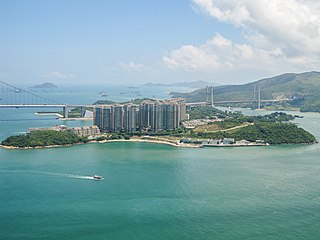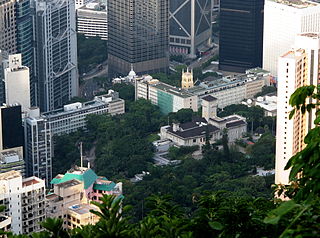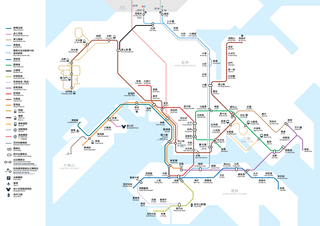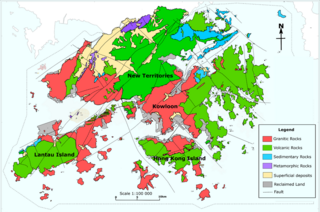
The Government of the Hong Kong Special Administrative Region, commonly known as the Hong Kong Government or HKSAR Government, is the executive authorities of Hong Kong. It was formed on 1 July 1997 in accordance with the Sino-British Joint Declaration of 1983, an international treaty lodged at the United Nations. This government replaced the former British Hong Kong Government (1842–1997). The Chief Executive and the principal officials, nominated by the chief executive, are appointed by the State Council of the People's Republic of China. The Government Secretariat is headed by the Chief Secretary of Hong Kong, who is the most senior principal official of the Government. The Chief Secretary and the other secretaries jointly oversee the administration of Hong Kong, give advice to the Chief Executive as members of the Executive Council, and are accountable for their actions and policies to the Chief Executive and the Legislative Council.

Ma Wan is an island of Hong Kong, located between Lantau Island and Tsing Yi Island, with an area of 0.97 square kilometres. Administratively, it is part of Tsuen Wan District.

The Former Central Government Offices, now called Justice Place, is an office building complex that formerly housed most of the major offices of the Hong Kong Government. The complex is located in Central, Hong Kong, occupying the lower level of Government Hill. The offices of the government have been relocated to the Main Block of the Central Government Complex, Tamar.

Cha Kwo Ling is a hill in the eastern New Kowloon area of Hong Kong, and the area around it. It is adjacent to Victoria Harbour and located to the west of Yau Tong and southwest of Lam Tin. Administratively, it belongs to the Kwun Tong District. The northeastern entrance to the Eastern Harbour Crossing is located in this area.

The Government Secretariat is collectively formed by the Offices of the Chief Secretary and the Financial Secretary and thirteen policy bureaux.

Several future projects on the MTR have been put forward by the MTR Corporation to the Hong Kong Government. Some of these are still in planning stage, some are now completed.

The geology of Hong Kong is dominated by igneous rocks formed during a major volcanic eruption period in the Mesozoic era. It made up 85% of Hong Kong's land surface and the remaining 15% are mostly sedimentary rocks located in the northeast New Territories. There are also a very small percentage of metamorphic rocks in the New Territories, formed by deformation of pre-existing sedimentary rocks (metamorphism).

The Development Bureau is an agency of the Government of Hong Kong responsible for urban planning and renewal, land administration, infrastructure development, building safety, landscape, greening & tree development, water supplies, flood prevention and heritage conservation.
Geoprofessions is a term coined by the Geoprofessional Business Association to connote various technical disciplines that involve engineering, earth and environmental services applied to below-ground (“subsurface”), ground-surface, and ground-surface-connected conditions, structures, or formations. The principal disciplines include, as major categories:

Wong Kam-sing, GBS, JP, is a Hong Kong architect and the former Secretary for the Environment, Wong had held a number of public service positions before joining the Government, including the first Chairman of the Environment and Sustainable Development Committee of the Hong Kong Institute of Architects, the Chairman of the Professional Green Building Council and the Vice Chairman of the Hong Kong Green Building Council. He has contributed to the promotion and research of the standards and guidelines for sustainable built environment applicable to the high-density urban environment of Hong Kong.

Highways Department is a department of the Hong Kong Government responsible for developing Hong Kong's road and railway network as well as road maintenance.

Mining in Hong Kong refers to mining activities in Hong Kong. Despite its small size, Hong Kong has a relatively large number of mineral deposits. Although some have been mined commercially, there are currently no commercial mining operations in Hong Kong.
The Hong Kong 2030: Planning Vision and Strategy is a study group tasked with preparing a strategic land use planning framework for Hong Kong up to year 2030. The HK2030 Study aimed to provide strategic framework for future land use in New Territories to address long-term housing demands in the New Development Areas (NDAs) of Kwu Tung North (KTN) and Fanling North (FLN). In 2008 “The North East New Development Areas Planning and Engineering Study” began; it continued until 2013.

Cheung Chau Ferry Pier serves the island of Cheung Chau, New Territories, Hong Kong. It is located on Praya Street within the Cheung Chau Typhoon Shelter.

Turret Hill, also known as Nui Po Shan, is a peak southeast of Tolo Harbour in the New Territories of Hong Kong. It has a height of 399 metres. The mountain is located in the Sha Tin District.

Ma On Shan Village or Ma On Shan Tsuen is a mining village in the hills of Ma On Shan, Sha Tin District, Hong Kong. The village grew around the activity of the Ma On Shan Iron Mine, which reached its peak during the 1950s-60s and ceased operation in 1976. It had historically two churches, St. Joseph's Church and Lutheran Yan Kwong Church.

Charles Ng Wang-wai is the first CLP Holdings Professor of Sustainability and Chair Professor in the Department of Civil and Environmental Engineering at the Hong Kong University of Science and Technology (HKUST). He is also the vice-president of HKUST (Guangzhou) and the dean of the Fok Ying Tung Graduate School at HKUST, Clear Water Bay Campus. He is the immediate past president of the International Society for Soil Mechanics and Geotechnical Engineering (ISSMGE), where he served as the 17th President from 2017 to 2022.

The PolyU Faculty of Construction and Environment is one of the faculty at the Hong Kong Polytechnic University. The faculty consists of the Department of Building and Real Estate, Department of Building Services Engineering, Department of Civil and Environmental Engineering, and Department of Land Surveying and Geo-Informatics. In 2021, the faculty has around 115 full-time academic staff.

The Public Works Department was a department of the Hong Kong Government.


















